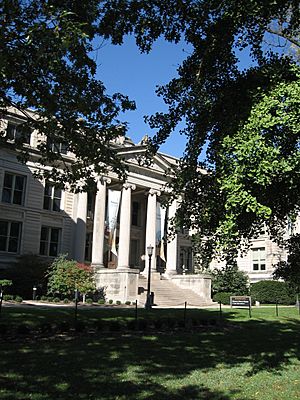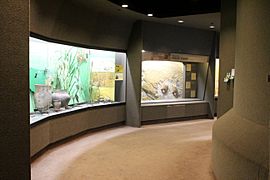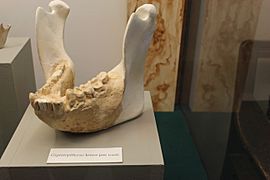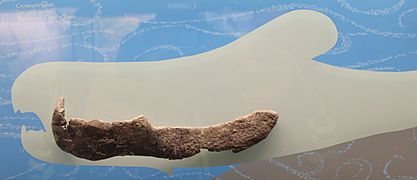University of Iowa Museum of Natural History facts for kids

Entrance to the University of Iowa Museum of Natural History
|
|
| Former name | University of Iowa Cabinet of Natural History |
|---|---|
| Established | 1858 |
| Location | 17 N Clinton St. University of Iowa Iowa City, Iowa, US |
| Type | Natural history museum |
| Accreditation | American Alliance of Museums |
| Collections | |
| Collection size | 140,000 objects |
The University of Iowa Museum of Natural History is a cool place to explore nature and history! It's a natural history museum located on the University of Iowa campus in Iowa City, Iowa. The museum started way back in 1858. It was first called the Cabinet of Natural History.
Today, the museum is inside Macbride Hall. This building is in the Pentacrest area of the university. The museum has about 140,000 items in its collections. These include many birds, eggs, nests, and mammal specimens. There are also lots of insects and other small creatures. You can see archaeological finds and historical documents too. The museum has several floors with different exhibits. These shows cover Iowa's geology, culture, amazing biological diversity, and environmental science. Some special collections include ancient stone tools, bird collections, and artifacts from the Inuit people. There are also items from the Philippines that were shown at the 1904 World's Fair.
Contents
History of the Museum
The museum began as a "cabinet" in 1858. The Iowa General Assembly wanted a place to keep items from state surveys. These surveys looked at Iowa's natural history and geology. The first home for this Cabinet of Natural History was the Iowa Old Capitol Building. This was the only university building at that time.
The first person in charge was a paleontologist named James Hall. But he left his job. Then, in 1859, Theodore S. Parvin became the second curator. During this time, the museum mostly collected geological items.
Later, geologist Samuel Calvin became the fourth curator. He asked for more money for the museum's fossil, bird, and mammal collections. Because of this, the Cabinet of Natural History moved in 1885. It went to the Science Hall, which is now called Calvin Hall. Two years later, in 1887, its name changed to the Museum of Natural History.
Growth and New Buildings
Charles Cleveland Nutting, a zoologist, became curator in 1876. He set up cool glass displays of specimens. These displays became very popular on campus. Nutting also led important trips to places like Dry Tortugas and The Bahamas. These trips brought in many new specimens. By 1895, the museum needed a bigger space. So, a new Natural Sciences Building was built. It was finished in 1908 and is now called Macbride Hall.
After 1926, when Homer R. Dill took over, the museum collected fewer new items. In 1965, the university president wanted to close the museum. But students, teachers, and alumni protested. They saved the museum!
To help the museum get strong again, George D. Schrimper became curator in 1972. He focused on making the exhibits more modern and exciting. One big project was creating a new gallery called Iowa Hall in 1985. By 1992, about 60,000 people visited the museum each year.
What You Can See: Permanent Exhibits
The museum has many exciting permanent exhibits for visitors to explore:
- Diversity of Life: This exhibit shows historic displays from the museum's past. It covers topics like ecology, geology, taxidermy, and how many different kinds of living things there are. It highlights important animal groups.
- Iowa Hall: Located on the first floor, this exhibit tells the story of life in Iowa through time. You can see models of ancient environments. These include a Devonian coral reef and a Pennsylvanian coal swamp. There's also a model of Jefferson's ground sloth. Plus, you can learn about Paleoindians and the Meskwaki tribe.
- Mammal Hall: On the third floor, this hall displays taxidermied animals and skeletons of various mammals. University staff and students collected these specimens. You can see the skeleton of an Atlantic right whale. There's also a taxidermied giant panda!
- William and Eleanor Hageboeck Hall of Birds: Also known as "Taking Flight: The World of Birds," this exhibit is on the third floor. It teaches about the life, ecology, and evolution of birds. It has over 1,000 bird specimens. These include almost all bird species that live in or visit Iowa. A special part is the historic Laysan Island Cyclorama. This gives you a 360-degree view of the birds on Laysan Island from long ago.
- Biosphere Discovery Hub: This is the museum's newest exhibit, opened in 2007. It's inside the Hageboeck Hall of Birds. This exhibit shows how humans and their environment interact. It also highlights environmental concerns caused by people.
-
Diorama of an ancient coal swamp in Iowa Hall
-
Displays showing Paleoindian artifacts in Iowa Hall
-
A replica of a Gigantopithecus blacki jaw
-
Fossil jaw of Dunkleosteus
Tarkio Valley Sloths
From 2002 to 2010, the museum helped dig up ancient sloth bones. They found at least three Megalonyx jeffersonii sloths near Shenandoah, Iowa. More recently, they found a fourth ground sloth. This one was a different species called Paramylodon harlani. This was the first time this type of sloth was found in Iowa!






